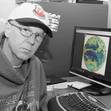David Billingsley's Blog, page 3
January 5, 2018
Evocative settings
“…his beautifully descriptive words that expertly paint a picture of the Idaho wilderness.”
“I grew up in the Northwest, and his descriptions of the areas the novel traverses are spot on.”
“…the author’s deft hand at describing the Idaho wilderness…”
The above quotes are from the few early reviews of The Switch. Setting is really important to my stories (to all stories); I’ve worked hard to reach the happy compromise of telling enough, but not too much. Some authors poetically describe landscapes or cityscapes, and their descriptive passages narratively wax on for paragraphs or even pages. Others give sparse descriptions, leaving the reader to mostly fill in the blanks. My strategy is to find that middle ground and let the reader conjure up the scene with enough tidbits of information to place them there. Of course, for someone who has been to central Idaho or any wilderness area in the West, the work of placing them in the environment is easy. But it’s not enough to put someone there. I have to strike a mood effected partially by the environment and let the readers feel it from the characters’ experiences. In The Switch, the Idaho wilderness, at least to Macy, is lonely and cold, but spectacularly beautiful at the same time. The remoteness is both exciting, yet for a woman surrounded by five million people at home, there is also a sense of uneasiness, even danger. Early on back in DFW, when she sits in the heat and humidity at a cafe table waiting on her friend, she is irritated and has little patience for the crowd around her. Most anyone from Texas or the southeast can imagine that. 
December 31, 2017
New Year’s Resolution
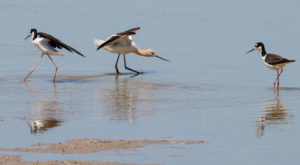
I don’t really do New Year’s resolutions because nobody sticks to them. The most obvious example is the throngs of people who will show up at my gym over the next six weeks. They will promptly disappear about mid-February. Happens every year.
Why make a promise on an artificial day of the year?
There are a couple of things I WILL complete in 2018.
My third book – The Connection – will be published some time in 2018. Given it was really my first book and thus I’m working from a completed first draft, publishing it this coming year should not be a stretch. What excites me is how the book starts off with a bang. Probably my best beginning (first few chapters), even though its my first book. The Connection takes place in a small West Texas town, has a bit of a science-fiction flavor, but also sticks to the writing and twists-and-turn style of my first two books.
First draft of my fourth book. Untitled. This one will be a departure, and it has something to do with weather. The setting is the Texas coast, so that should tell you something.

December 20, 2017
My fondest of 2017
 One of the websites I use to display my photography, Smugmug, sent me an email asking about my favorite moment of 2017. Clearly, it was during totality of the solar eclipse. I’m fortunate to live only a few hundred miles from the path of totality and have a niece who lives right in the path (dark dot in eastern Idaho). So my first order of business: let my niece know I’d be there! Think I texted her a year or more in advance.
One of the websites I use to display my photography, Smugmug, sent me an email asking about my favorite moment of 2017. Clearly, it was during totality of the solar eclipse. I’m fortunate to live only a few hundred miles from the path of totality and have a niece who lives right in the path (dark dot in eastern Idaho). So my first order of business: let my niece know I’d be there! Think I texted her a year or more in advance.
My first decision: should I spend my time photographing the event or let the legions of veteran photographers do it while I sit in a lawn chair and watch the event with my eclipse glasses.
The answer was easy. I would photograph my first eclipse.
I wanted to be realistic since I’d never done any photography like this. If I could get some usable, sharp images of the event, I would be happy. But what I really wanted: a montage of the entire eclipse.
Preparation
My camera prep started roughly six months before the event. I read up on filters, cameras, settings, process, dos and don’ts from the experts, etc. Advice was readily abundant and all over the place. “Don’t risk pointing your camera at the sun.” “Don’t use ND filters.” “Practice!” “Don’t forget to stop photographing and look around during totality.” “Watch out for people around your camera; they tend to get excited.”
At first, I thought about using my old APS-C camera body so I wouldn’t have to worry about my brand-new full-frame Canon. The decision of which lens to use was easy–my 400mm fixed series L lens. The sun would be large enough in the frame but also wouldn’t move so fast that I’d be continually adjusting the position. And it would work on either camera body.
Next, a filter. Most reasonable advice said not to use ND filters; it was unclear whether the issue was with damaging your camera or your eyes (looking through the viewfinder since infrared and some UV light would pass through ND filters). So I went to a local camera store and bought a Mylar solar filter on a cardboard body. Cost about 20 bucks. Simply tape it to the lens. Note for the Texas eclipse in 2024: buy two of the filters. They are cheap and if you accidentally damage your only filter, you’re screwed. I did get a little nick in the filter before the event started, but it did not impact my pictures.
A few weeks prior, I made the command decision to use my full-frame body. This was a once (or maybe twice) in a lifetime opportunity, so I wanted to use the best I had.
Next up. Practice. Great piece of advice. A few weeks before the event, I put the filter on the lens and took a few shots of the sun at different times of the day. Noted the settings, etc. The hour and twenty minutes before and after totality were a concern, but I would have lots of time to adjust. The hardest part would be readying myself for the whopping couple of minutes of totality. I knew that just before totality, I would have to remove the filter, risk taking unfiltered shots of the “diamond ring,” then Bailey’s Beads, and finally totality. Same as the sun emerged on the other side. There was no real way to practice this. One of my test shots:
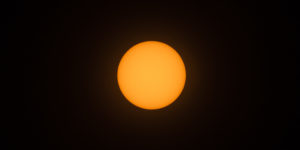
The day before, I went out about 1:30 p.m., roughly the time of totality, and took a series of images with my filter, to familiarize myself with the sun’s position in the sky and it’s movement in my 400mm lens. Tried a number of exposure settings. Settled on f/9.0 at 1/50, 1/100, and 1/200th of a second, all at ISO 100. I was as ready as I would ever be.
The Weather
MyOtherWork, my Twitter handle, refers to photography and writing fiction. My day job is a meteorologist for the federal government, and I have some expertise because I spent a number of years forecasting in Idaho. Given the date of the eclipse was August, I was more worried about wildfire smoke than clouds or rain. And that threat was around weeks before the eclipse. Fortunately, smoke and fire activity waned before the event, yet there was a weak weather disturbance forecast to stall somewhere close to the path where I would be. The issue: a band of clouds that would stretch out mostly east to west somewhere near my position. Since I was going to my niece’s place, I’d decided I would not “chase” the eclipse if the conditions were not perfect in Idaho Falls. In other words, I would take what Idaho Falls would give me. God was watching over me. The band of clouds stretched east to west roughly a hundred miles south of my position. In Idaho Falls, clear skies!
The Event
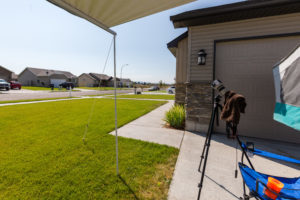
Here was my set-up in Idaho Falls, Idaho on 8/21/2017. At about noon, I set-up my tripod, camera, filter, chair, etc. and waited. It was hot by Idaho standards (low 80s). Behind me, private jet after private jet flew into the Idaho Falls Airport. Apparently, clouds were obscuring the event in parts of Wyoming (Jackson), so the top 1% got in their planes and flew into an oversubscribed Idaho Falls airfield.
Note the clear skies.
I used my phone as a timer. At 12:31, I took the first image. The first evidence of eclipse came at 12:38. For roughly the next hour and fifteen minutes, I took the same three exposures (mentioned above) every five minutes. I never used the viewfinder; periodically I would adjust my focus using zoomed liveview on the edge of the sun’s surface. It’s a bit of a trick to hide under a towel, look at the screen, and adjust the focus (with my bifocals on). My extended family was wonderful; they were all on the front porch with the glasses I bought for them, leaving me to my “zone” by the garage.
Here’s the first shot with evidence of the eclipse (1/100th, f/9.0, ISO 100):

Diamond Ring and Totality
The part that worried me the most was removing the filter and attempting a few shots just as totality occurred. I wanted to capture the diamond ring and was pretty sure it was safe for my camera, but I’d never done this. Once totality occurred, I rapidly took shots varying my shutter from 1/2000th up to 1/50th of a second, all at f/9.0. Most of the nicer shots were in the same range as when I used the filter. The one mistake I made in all of this: in my excitement through totality, I never refocused like I did before and after totality. Hence, I could have recorded slightly sharper totality images, but they were certainly good enough for me. Here’s one going into totality–the diamond ring, and of course, the star (haha) of the show–totality:

Note a little blue tint in the diamond ring. Just a different exposure. After totality, I put the filter back on and continued the three exposures every five minutes for the next hour and fifteen minutes.
The Montage
And the final result after a lot of work at home on PS:
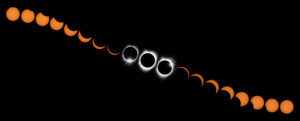
Needless to say, I was pleased. On to Kerrville, April 8th, 2024.
December 8, 2017
The Hardest Part
“Overnight success is almost always a myth. Half of this industry is luck, and half is the refusal to quit.” – Victoria Schwab, American Fantasy Author.
Book 1 done. Book 2 out. Did better on The Redemption, book one, than I would have imagined. The Switch, book two, is ahead of The Redemption in early sales. So what’s the problem?
It’s that nagging period where your book is in the hands of a few dozen readers, and you wonder if they like it. Is it any good? Now, not everyone needs to like the book. That would be an unreasonable goal. But you’re hoping the people that liked the last book will like this one.
There should be a name for this period. It’s certainly the wildly fluctuating “I know what I’m doing” vs “This is crap!” period. I’m a very small-time author trying to gain a few hundred readers. Can’t imagine what a big-time author feels during this period, though they have the advantage of test-readers, publicists, big publishing houses, etc. But it still must be tough.
So what to do? Get moving on The Connection, my third book. And start working on better marketing methods – I’m going to test an email subscriber list. Most advice says this is the best way to connect with readers. We’ll see. We all have so much email. But if I keep the list contents to an email a month, will that be enough to keep interest? Or will it be too much? Too little? Will it be interesting? Am I interesting? Argghhh…right back to where I was waiting on the book reviews!
As an aside, every time I read the prologue to The Connection, my next effort, I sit back and think, “That’s damn good! How could you not keep reading? I know what I’m doing.” 
December 3, 2017
A mini interview
For this week’s blog post, I thought I would interview myself, an always instructive exercise. Only six questions. 

